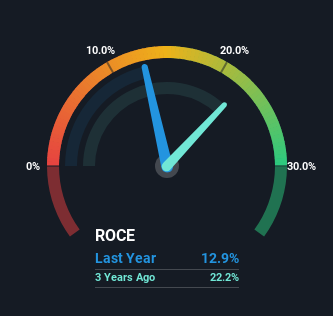- United Kingdom
- /
- Healthcare Services
- /
- LSE:IDHC
Integrated Diagnostics Holdings (LON:IDHC) Will Be Hoping To Turn Its Returns On Capital Around

If we want to find a stock that could multiply over the long term, what are the underlying trends we should look for? Amongst other things, we'll want to see two things; firstly, a growing return on capital employed (ROCE) and secondly, an expansion in the company's amount of capital employed. Basically this means that a company has profitable initiatives that it can continue to reinvest in, which is a trait of a compounding machine. However, after briefly looking over the numbers, we don't think Integrated Diagnostics Holdings (LON:IDHC) has the makings of a multi-bagger going forward, but let's have a look at why that may be.
Return On Capital Employed (ROCE): What Is It?
If you haven't worked with ROCE before, it measures the 'return' (pre-tax profit) a company generates from capital employed in its business. Analysts use this formula to calculate it for Integrated Diagnostics Holdings:
Return on Capital Employed = Earnings Before Interest and Tax (EBIT) ÷ (Total Assets - Current Liabilities)
0.13 = ج.م535m ÷ (ج.م5.5b - ج.م1.3b) (Based on the trailing twelve months to June 2023).
So, Integrated Diagnostics Holdings has an ROCE of 13%. On its own, that's a standard return, however it's much better than the 11% generated by the Healthcare industry.
See our latest analysis for Integrated Diagnostics Holdings

In the above chart we have measured Integrated Diagnostics Holdings' prior ROCE against its prior performance, but the future is arguably more important. If you'd like to see what analysts are forecasting going forward, you should check out our free report for Integrated Diagnostics Holdings.
How Are Returns Trending?
When we looked at the ROCE trend at Integrated Diagnostics Holdings, we didn't gain much confidence. Over the last five years, returns on capital have decreased to 13% from 25% five years ago. Given the business is employing more capital while revenue has slipped, this is a bit concerning. This could mean that the business is losing its competitive advantage or market share, because while more money is being put into ventures, it's actually producing a lower return - "less bang for their buck" per se.
The Bottom Line
From the above analysis, we find it rather worrisome that returns on capital and sales for Integrated Diagnostics Holdings have fallen, meanwhile the business is employing more capital than it was five years ago. It should come as no surprise then that the stock has fallen 51% over the last five years, so it looks like investors are recognizing these changes. That being the case, unless the underlying trends revert to a more positive trajectory, we'd consider looking elsewhere.
Integrated Diagnostics Holdings does have some risks though, and we've spotted 3 warning signs for Integrated Diagnostics Holdings that you might be interested in.
While Integrated Diagnostics Holdings may not currently earn the highest returns, we've compiled a list of companies that currently earn more than 25% return on equity. Check out this free list here.
New: AI Stock Screener & Alerts
Our new AI Stock Screener scans the market every day to uncover opportunities.
• Dividend Powerhouses (3%+ Yield)
• Undervalued Small Caps with Insider Buying
• High growth Tech and AI Companies
Or build your own from over 50 metrics.
Have feedback on this article? Concerned about the content? Get in touch with us directly. Alternatively, email editorial-team (at) simplywallst.com.
This article by Simply Wall St is general in nature. We provide commentary based on historical data and analyst forecasts only using an unbiased methodology and our articles are not intended to be financial advice. It does not constitute a recommendation to buy or sell any stock, and does not take account of your objectives, or your financial situation. We aim to bring you long-term focused analysis driven by fundamental data. Note that our analysis may not factor in the latest price-sensitive company announcements or qualitative material. Simply Wall St has no position in any stocks mentioned.
About LSE:IDHC
Integrated Diagnostics Holdings
A consumer healthcare company, provides various medical diagnostics services to patients.
Outstanding track record with flawless balance sheet.
Market Insights
Community Narratives




